
Nymphaea is a genus of hardy and tender aquatic plants in the family Nymphaeaceae. The genus has a cosmopolitan distribution. Many species are cultivated as ornamental plants, and many cultivars have been bred. Some taxa occur as introduced species where they are not native, and some are weeds. Plants of the genus are known commonly as water lilies, or waterlilies in the United Kingdom. The genus name is from the Greek νυμφαία, nymphaia and the Latin nymphaea, which mean "water lily" and were inspired by the nymphs of Greek and Latin mythology.
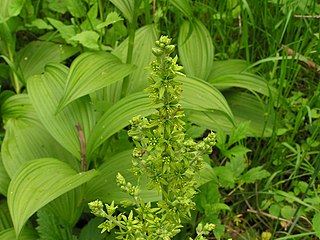
Veratrum viride, known as Indian poke, corn-lily, Indian hellebore, false hellebore, green false hellebore, or giant false-helleborine, is a species of Veratrum native to eastern and western North America. It is extremely toxic, and is considered a pest plant by farmers with livestock. The species has acquired a large number of other common names within its native range, including American false hellebore, American white hellebore, bear corn, big hellebore, corn lily, devils bite, duck retten, itch-weed, itchweed, poor Annie, blue hellebore and tickleweed.

Dichopogon strictus, commonly known as chocolate lily, is a herbaceous perennial plant species native to Australia.
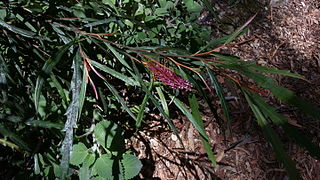
Grevillea longifolia, the fern-leaf spider flower, is a plant of the family Proteaceae, formerly known as Grevillea aspleniifolia. Commonly growing in the Sydney basin of central New South Wales, Australia Grevillea longifolia is recognizable by its deep red "toothbrush" flowers which appear in spring, and narrow, sawtoothed leaves. It is fairly readily grown in gardens.

Ornithogalum umbellatum, the garden star-of-Bethlehem, grass lily, nap-at-noon, or eleven-o'clock lady, a species of the genus Ornithogalum, is a perennial bulbous flowering plant in the asparagus family (Asparagaceae). O. umbellatum is a relatively short plant, occurring in tufts of basal linear leaves, producing conspicuous white flowers, in a stellate pattern, in mid to late spring. The flowers open late in the day, but when closed have a green stripe on the outside. It is native throughout most of southern and central Europe, and north-western Africa. O. umbellatum is often grown as a garden ornamental, but in North America and other areas it has escaped cultivation and can be found in many areas, where it may become an invasive noxious weed. Parts of the plant are considered poisonous, but are used in some regional cuisines. Essences are also sold as patent remedies. O. umbellatum has been depicted in art by artists such as Leonardo da Vinci, and folklore has suggested it originally grew from fragments of the star of Bethlehem, hence its horticultural name.

Dianella is a monocot genus of flowering plants. They are commonly called flax lilies.
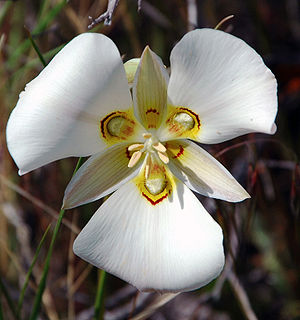
Calochortus nuttallii — known as sego lily — is a bulbous perennial which is endemic to the Western United States.

Stypandra is a small genus of rhizomatous perennials in the family Asphodelaceae, subfamily Hemerocallidoideae. They are native to Australia and New Caledonia.

Eriogonum umbellatum is a species of wild buckwheat known by the common name sulphurflower buckwheat, or simply sulphur flower. It is native to western North America from California to Colorado to central Canada, where it is abundant and found in many habitats. This is an extremely variable plant and hard to identify because individuals can look very different from one another. Also, there are a great many varieties. It may be a perennial herb forming a small clump with flowers to 10 centimeters tall, or a sprawling shrub approaching two meters high and wide. The leaves are usually woolly and low on the plant, and the flowers come in many colors from white to bright yellow to purple. Native American groups utilized parts of this plant for a number of medicinal uses.

Lambertia formosa, commonly known as mountain devil, is a shrub of the family Proteaceae, endemic to New South Wales, Australia. First described in 1798 by English botanist James Edward Smith, it is the type species of the small genus Lambertia. It is generally found in heathland or open forest, growing in sandstone-based soils. It grows as a multistemmed shrub to around 2 m (7 ft) with a woody base known as a lignotuber, from which it regrows after bushfire. It has stiff narrow leaves, and the pink to red flowerheads, made up of seven individual tubular flowers, generally appear in spring and summer. It gains its common name from the horned woody follicles, which were used to make small devil-figures.

Thysanotus patersonii, the twining fringe-lily, is a climbing perennial herb which is endemic to Australia.

Thelionema is a small genus of tufted perennials in the family Asphodelaceae, subfamily Hemerocallidoideae. All three species, which were previously placed in the genus Stypandra, are native to Australia. These are:

Thelionema caespitosum, the tufted lily or tufted blue-lily, is a species of perennial herb, native to Australia. The lily-like flowers are blue, light blue, pale yellow or white and have yellow stamens.

Caesia parviflora, the pale grass lily, is a species of flowering plant in the family Asphodelaceae, subfamily Hemerocallidoideae, native to Australia, being found in New South Wales, Queensland, Victoria, Tasmania, South Australia and Western Australia.

Lomatia myricoides, commonly known as the river lomatia, is a shrub native to New South Wales and Victoria in southeastern Australia.

Persoonia hirsuta, commonly known as the hairy persoonia or hairy geebung, is a shrub native to New South Wales in eastern Australia.
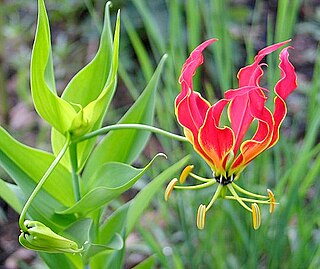
Gloriosa superba is a species of flowering plant in the family Colchicaceae. Common names include flame lily, climbing lily, creeping lily, glory lily, gloriosa lily, tiger claw, and fire lily.

Blue lily may refer to the following plant species:
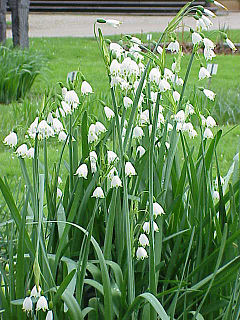
Leucojum aestivum, commonly called summer snowflake or Loddon lily, is a plant species widely cultivated as an ornamental. It is native to most of Europe from Spain and Ireland to Ukraine, with the exception of Scandinavia, Russia, Belarus and the Baltic Republics. It is also considered native to Turkey, Iran and the Caucasus. It is naturalized in Denmark, South Australia, New South Wales, Nova Scotia and much of the eastern United States.

Thelionema grande, the tufted granite lily is a species of perennial herb, native to Australia. Growing up to 125 cm high, the lily-like flowers are blue or rarely white with yellow stamens. The species occurs in Queensland and New South Wales. Found on sandy soils near granite outcrops. From altitutes over 800 metres in the northern ranges of New South Wales and adjacent areas in Queensland. First known as Stypandra grandis. The species was transferred to a new genus, Thelionema, in 1985.



















